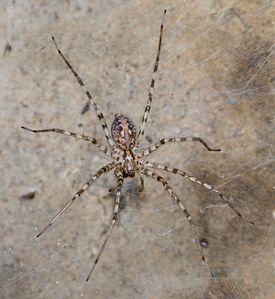House spider tegenaria: the eternal neighbor of man
Sooner or later, house spiders appear in any room. These are tegenaria. They don't harm people. The disadvantages of such a neighborhood include the unaesthetic appearance of the room. In these cases, you can simply get rid of the web.
Content
Tegenaria spider: photo
Name: Tegenaria
Latin: TegenariaClass: Arachnida - Arachnida
Squad: Spiders - Araneae
Family: Crows - Agelenidae
 | Habitats: | dark corners, cracks |
 | Dangerous for: | flies, mosquitoes |
 | Attitude towards people: | harmless, harmless |
Tegenaria is a representative of funnel-shaped spiders. They make a very specific housing in the form of a funnel, on which the web is attached.
Males reach a length of 10 mm, and females - 20 mm. There are short black stripes on the paws. The body is oblong. Long legs give the appearance of large spiders. The limbs are 2,5 times longer than the body.
The coloration is light brown. Some species have a beige tint. The pattern on the belly is diamond-shaped. Some varieties have leopard prints. Adults have 2 black stripes on the back.
Habitat
House spiders live near people. They settle in corners, crevices, baseboards, attics.
In natural conditions, it is difficult to meet them. In very rare cases, the habitats are fallen leaves, fallen trees, hollows, snags. In these places, the arthropod is engaged in weaving large and insidious tubular nets.
The habitat of the wall spider is Africa. Rare cases are known when representatives were found in Asian countries. Old and abandoned houses become places for building nests.
Features of the place of residence
An arthropod cannot live long in one web. This is due to the accumulation of the remains of caught insects in it. Tegenaria is characterized by a change of habitat every 3 weeks. The life expectancy of males is up to one year, and females - about two to three years.
Tegenaria lifestyle
A house spider spins a web in a dark corner. The web is non-sticky, it is distinguished by friability, which causes insects to get stuck. Only females are engaged in weaving. Males hunt without the help of a web.
Tegenaria is not interested in a stationary object. The arthropod throws a pedipalp onto the victim and waits for a reaction. To provoke an insect, the spider beats the web with its limbs. After the start of the movement, the tegenaria drags the prey to its shelter.
The arthropod lacks chewing jaws. The oral apparatus is small. The spider injects venom and waits for the prey to be immobilized. When absorbing food, it does not pay attention to the rest of the surrounding insects - which distinguishes the spider of this species from many others.
It is interesting that the spider does not always succeed. Sometimes the prey, as often happens with ants, behaves very actively and resists, which quickly exhausts the arthropod. Tegenaria simply gets tired and returns to its tube, and the insect quickly gets out.
Tegenaria diet
The diet of the spider is made up exclusively of those insects that are nearby. They lie in wait for their prey, being in one place. They eat:
- flies;
- larvae;
- worms;
- Drosophila;
- midges;
- mosquitoes.
Reproduction
Mating takes place in June-July. Males are very wary of females. They are able to watch females for hours. Initially, the male is at the bottom of the web. Gradually he rises. The arthropod overcomes every millimeter with caution, as the female can kill him.
The male touches the female and looks for a reaction. After mating, eggs are laid. Completion of this process leads to the rapid death of adult spiders. In one cocoon there are about a hundred spiderlings. At first they all stick together, but after a while they scatter into different corners.
Other developments are also possible:
- the failed father becomes dead;
- the female drives away the unworthy suitor.
Tegenaria bite
The poisonous substances of the spider kill any small insect. When the poison is injected, a paralyzing effect immediately occurs. The death of insects occurs after 10 minutes.
Home spiders do not touch people and pets. They usually hide and run away.
They attack when life is threatened. For example, if you pin down a spider. Of the symptoms of a bite, there is slight swelling, irritation, a speck. Within a few days, the skin regenerates on its own.
wall tegenaria
In total, there are 144 species of tegenaria spiders. But only a few are the most common. Most often, it is the house varieties that are found.
Wall tegenaria are similar to their counterparts, reaching a length of 30 mm. The span of the limbs is up to 14 cm. The color is reddish-brown. Curved paws give an intimidating look. This species is very aggressive. In search of food, they are able to kill relatives.
Interesting Facts
By the behavior of a domestic spider, you can predict the weather. Upon careful observation, interesting features were noticed:
- If the spider gets out of the nets and weaves its web, the weather will be clear.
- When the spider sits in one place and ruffled, the weather will be cold.
Conclusion
Tegenaria is absolutely harmless to humans. The benefit of spiders is the destruction of other small insects in the room. If desired, constant wet cleaning, cleaning hard-to-reach areas with a vacuum cleaner or a broom will help get rid of signs of the appearance of these domestic spiders in the home.
Previous

